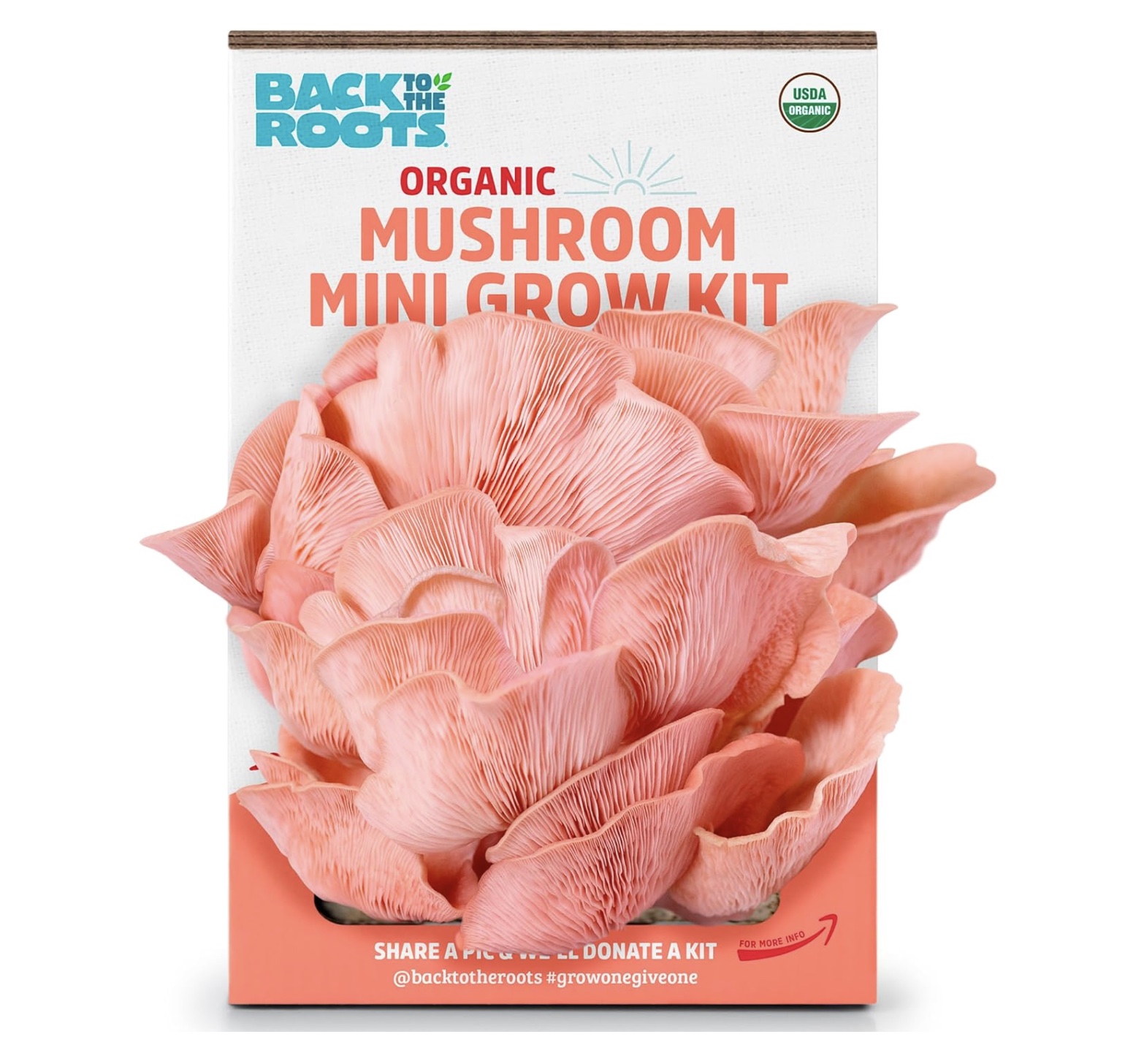Fall is a Great Time to Grow Gourmet Mushrooms – These 7 Easy Varieties Thrive in Damp Weather
Want to grow some of the most delectable autumn crops in weeks? Here are 7 of the easiest mushrooms to grow in fall, indoors and outdoors – for fleshy, flavorsome crops
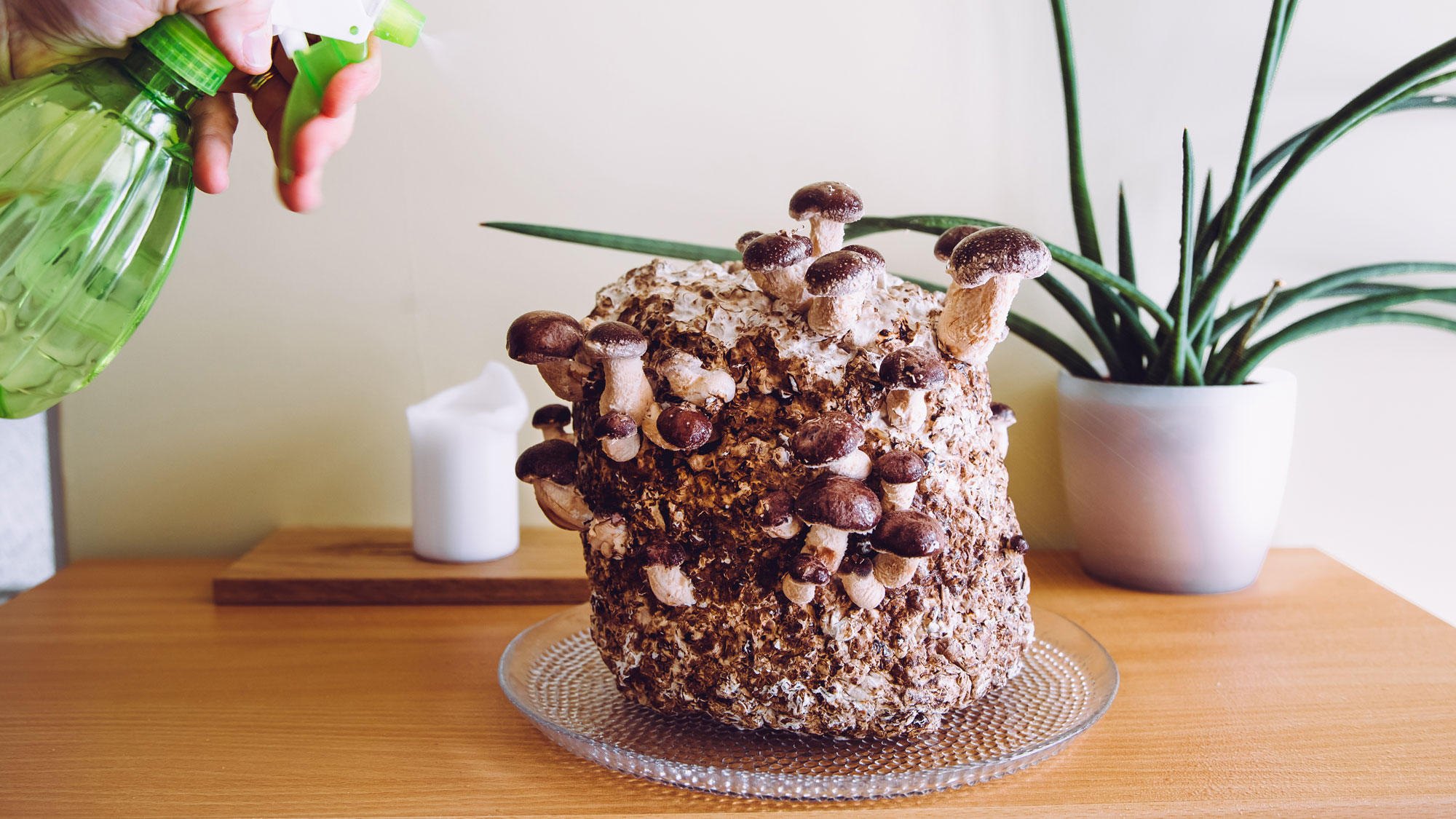
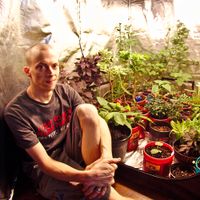
Amy Draiss
If you’re looking for the easiest mushrooms to grow in fall, there is some very tasty competition. What’s more, this time of year is perfect for starting, as fall’s natural climate carries the load. Harvests come easy, flavors stay bold, and whether you’re just starting out or already experienced, the process feels simple and satisfying.
Many of the easiest mushrooms flourish in fall’s cool climate, and damp conditions support their natural fruiting routine. These crops help to extend the edible garden beyond the first frost – and give you an exciting opportunity to create something impactful and daring for the dinner table. When you understand how to grow mushrooms, you can quickly turn basic substrates into savory, gourmet yields.
Beginner mushrooms benefit from fall’s stable weather, which minimizes contamination risks for first-time cultivators. Kits and simple tools make starting a breeze, even in limited spaces. Even urban gardeners can transform the smallest of areas, like a basement nook or shaded patio, into productive patches for meaty harvests. Here are 7 of the best mushrooms to grow in fall, with straightforward techniques suited to the season.
Growing Mushrooms in Fall: What You Need
Mushrooms thrive on 80-95% humidity, 50-75°F (10-24°C) temperatures, and dim light or shade. Indoors, you need a basement with a humidifier, like the Dreo Smart Humidifier from Amazon. You also need a still air box to keep mushrooms spotless, though a laminar flowhood adds pro-grade cleanliness for bigger runs.
Growing mushrooms outdoors, shaded beds of straw or fresh wood chips do the job, but fickle weather can botch inoculation – sterility is still key. Ready-to-fruit kits are easiest, and only require you to cut the bag and keep it clean. This is best for starters, while DIYers use agar, liquid culture, wooden spawn plugs and grain spawn. Spore-to-spawn requires razor-sharp sterile technique to dodge devastation.
For wood-loving mushrooms like oyster, lion’s mane, pioppino and chestnut, you need a mix of aspen shavings and pure oak pellets to fuel strong mycelium. Portobellos prefer composted manure or straw, while wine caps win out on fresh, bacteria-packed wood chips and compost. Whichever route you take, make sure you also have gloves, alcohol wipes, a misting bottle, and a thermometer like the ThermoPro TP50 Digital Hygrometer from Amazon to keep the setup tight.
Choosing the Right Mushroom Kits
Mushroom kits simplify cultivation for novices, offering pre-inoculated substrates that fruit with minimal effort. Oyster and lion’s mane are good for indoor spaces, needing only a spray bottle, like the Flairosol Botanica Plant Mister from Amazon that has an ultra-fine mist, and a cool, shaded corner.
Sign up for the Gardening Know How newsletter today and receive a free copy of our e-book "How to Grow Delicious Tomatoes".
Shiitake kits thrive in basements, while portobello kits work well in trays for garage or patio setups. Wine cap spawn excels in outdoor beds with fresh wood chips. Select kits based on your space – indoor for control, outdoor for larger yields.
Kits cut the complexity out of the process, delivering gourmet mushrooms in 2-6 weeks with basic care, perfect for fall’s forgiving conditions. There are plenty of kits available – but I especially love North Spore Organic’s Lion’s Mane Mushroom Spray & Grow Kit from Amazon, and Forest Origins’ Pink Oyster Mushroom Grow Kit from Amazon, for their simplicity and reliable results. The Gardening Know How Team also loves the Back to the Roots mushroom kits, also available from Amazon…
1. Oyster Mushrooms
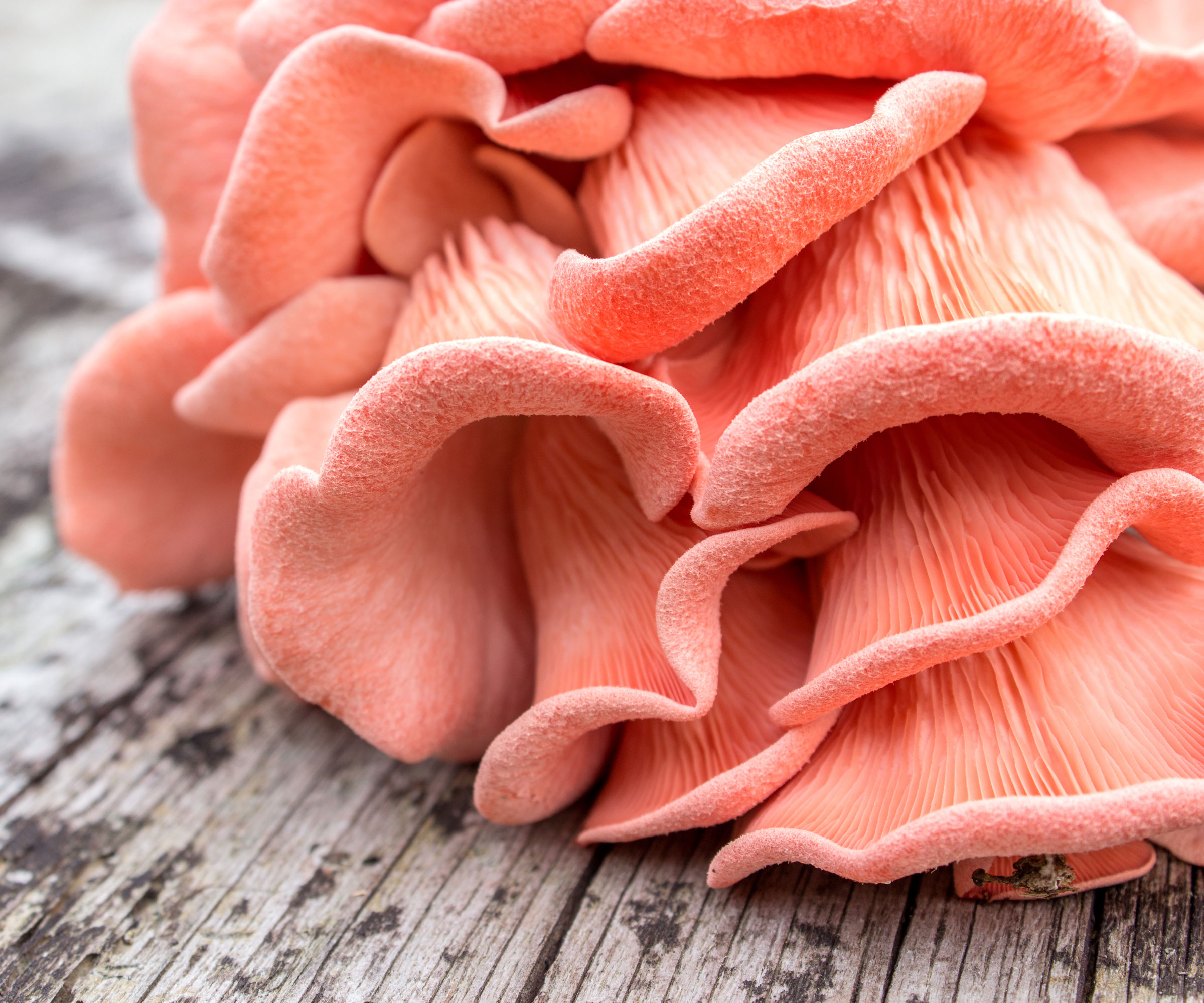
Oyster mushrooms (Pleurotus spp.) like to burst out on aspen shavings and oak pellets, or pasteurized straw, fruiting in 2-4 weeks at 60-70°F (16-21°C) with 85-95% humidity and soft light. Kits keep it dead simple for rookies, just needing a spray bottle and a shady nook.
An oyster mushroom’s nutty, buttery kick amps up stir-fries or pastas, ideal for apartment growers. A still air box ensures clean transfers, pumping out pearl, blue, or pink oysters for quick harvests. Outdoors, these mushrooms thrive on hardwood logs like oak or maple in shaded beds. These are some of the easiest mushrooms to grow.
2. Lion’s Mane
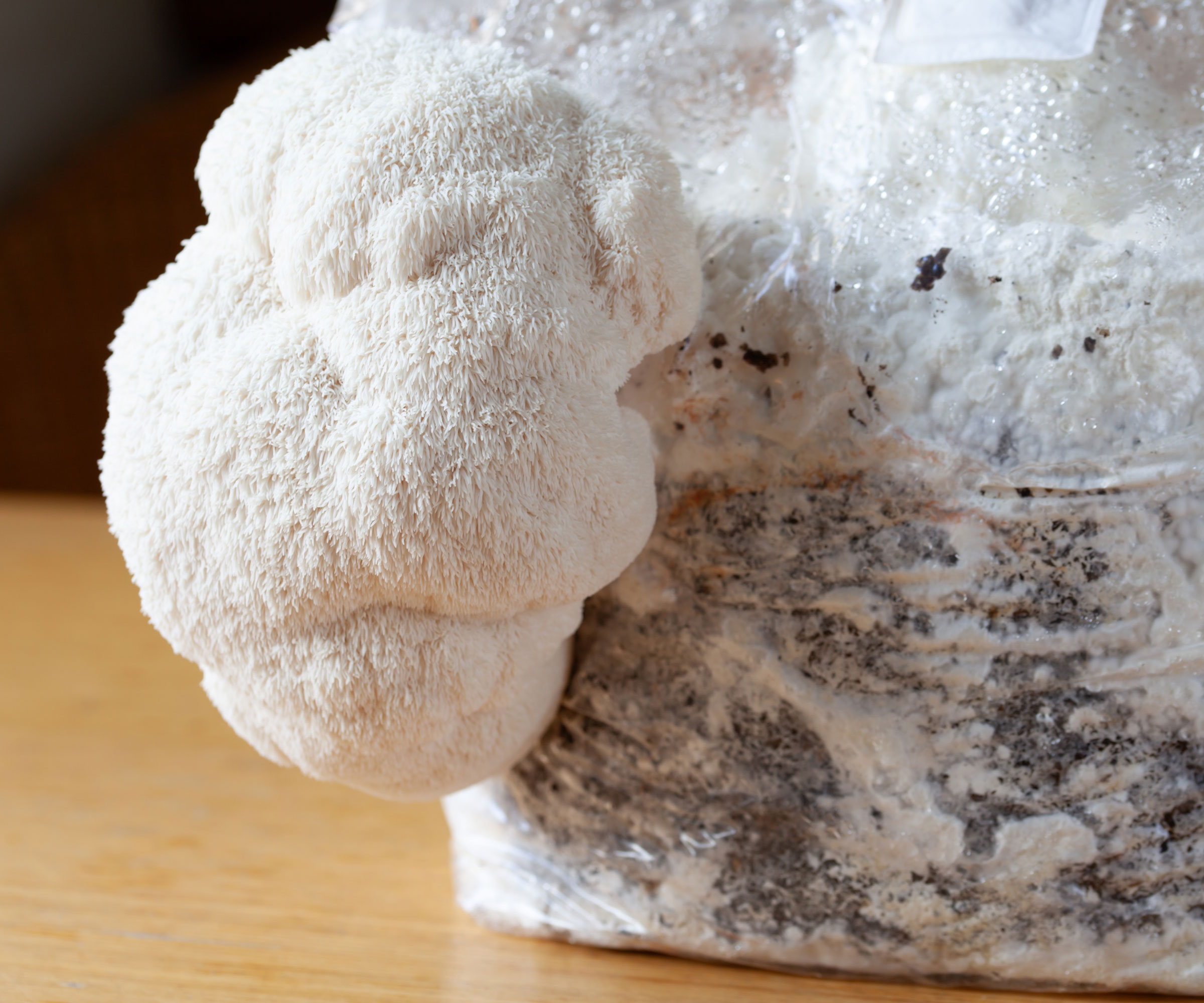
Lion’s mane (Hericium erinaceus) sprouts shaggy, white clusters on aspen shavings and oak pellets at 65-75°F (18-24°C) with 90% humidity. Kits make indoor growing a breeze, just needing a damp corner and low light.
Lion’s mane’s lobster-esque flavor pops in creamy soups or seared as a meat swap, perfect for health nuts chasing brain boosts. Outdoors, hardwood logs like beech or oak in shady spots work very well.
3. Wine Cap
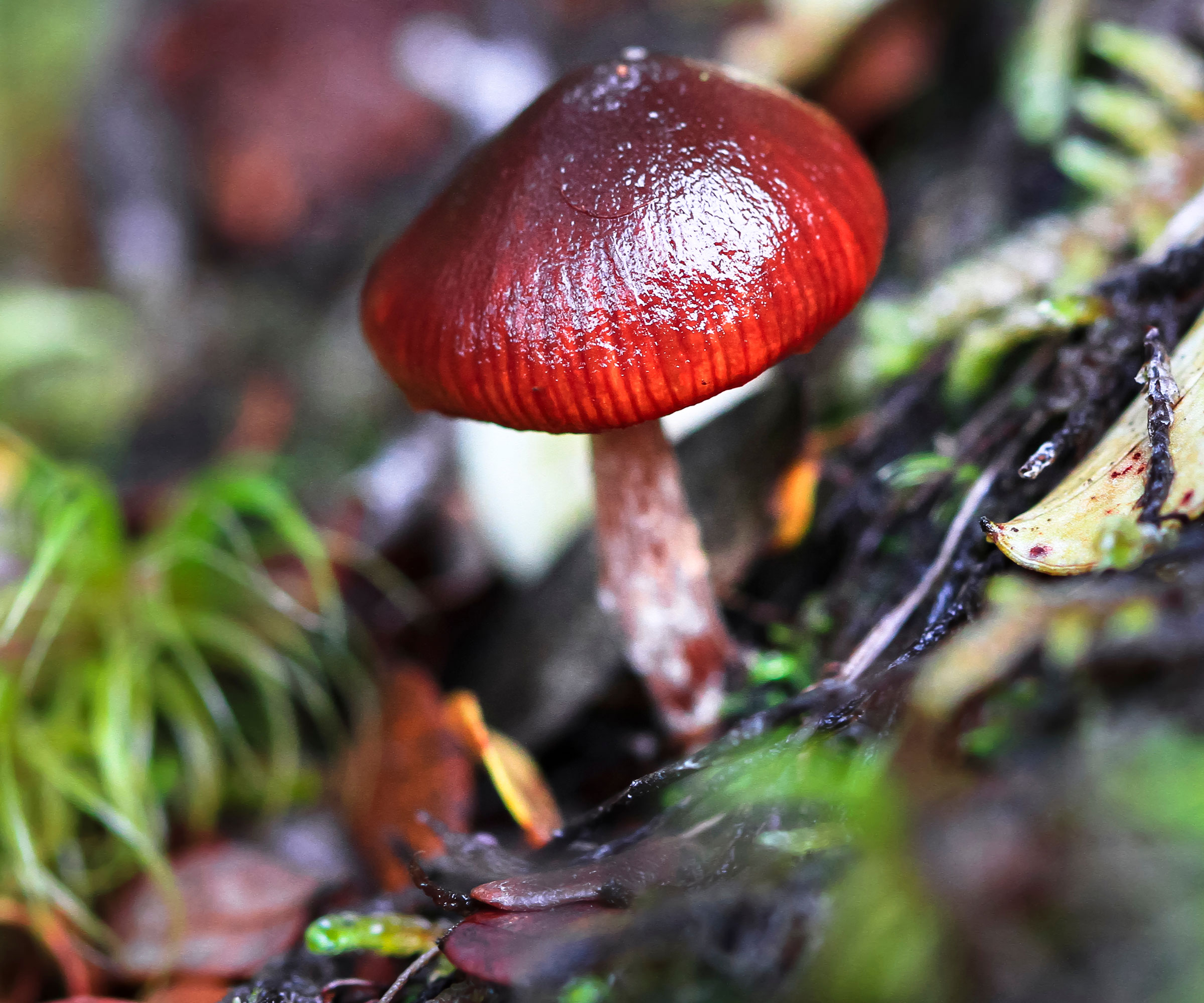
Wine caps (Stropharia rugosoannulata) grow beefy, reddish-brown caps in outdoor beds of fresh, bacteria-rich wood chips, compost, or soil. Indoor growing is trickier due to space and substrate demands. These mushrooms fruit at 50-70°F (10-21°C) in shaded spots.
Outdoor beds are great, but indoors you need bacteria-laced mulch ready to roll. The earthy depth of wine caps shine grilled or sautéed. Outdoors, fresh hardwood chips like oak or poplar boost rich, hearty yields.
4. Shiitake
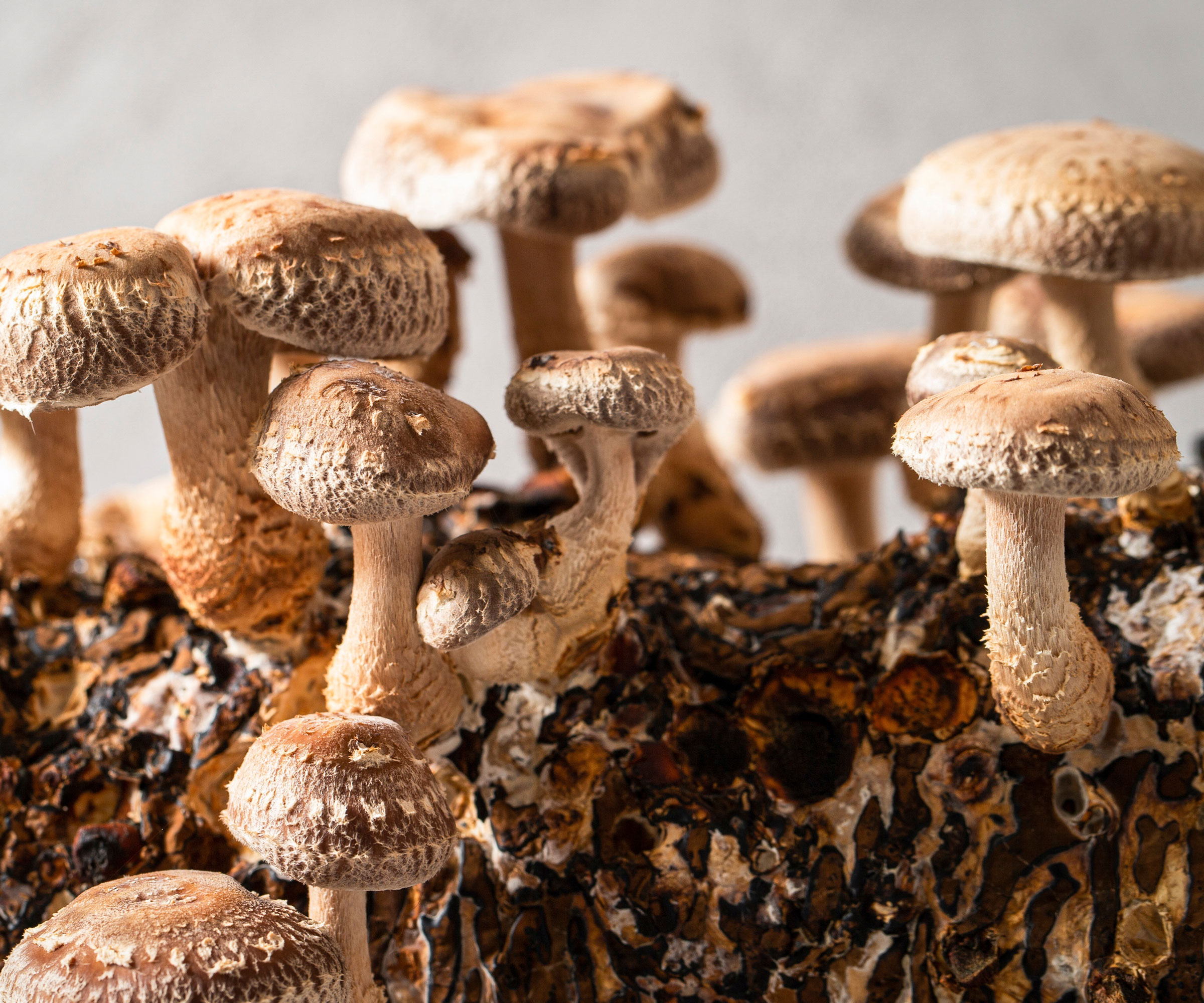
This is another easy beginner mushroom. At 60–70°F (16–21°C), 80–90% humidity, and low light, shiitakes (Lentinula edodes) push out their caps on oak pellets or hardwood logs. They are usually fruiting within 3–6 weeks.
If you’re new to mushroom growing, ready-to-fruit kits simplify the process. These umami-heavy caps lift risottos or stir-fries, and they are great for patient growers with basement space. Soaking logs overnight sparks faster fruiting. Outdoors, oak or maple logs in shaded areas are ideal.
5. Portobello
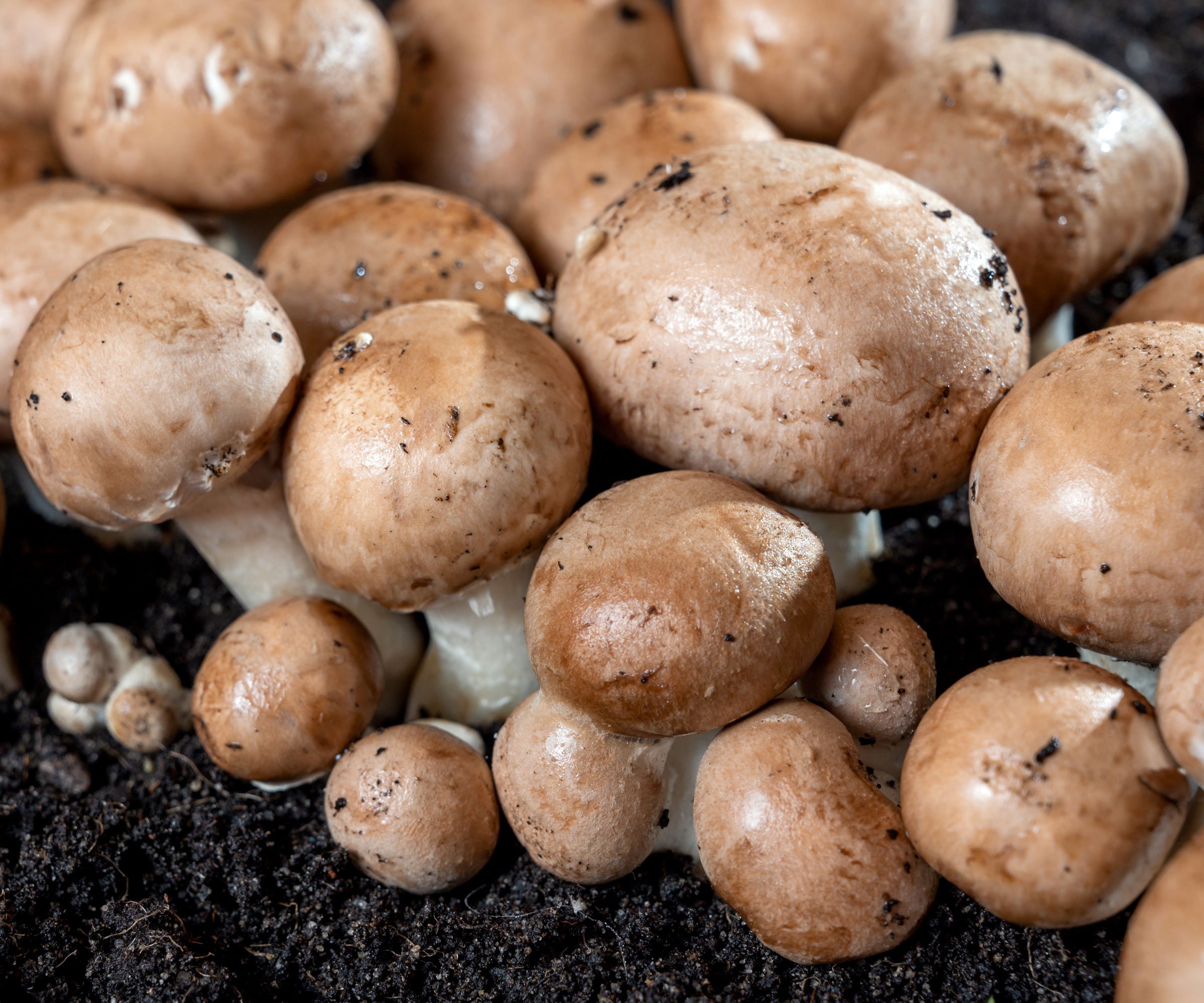
Portobellos (Agaricus bisporus) grow on composted manure or straw at 65-75°F (18-24°C) with 90% humidity, fruiting in 4-6 weeks. Kits make indoor or outdoor grows easy, so all you need is a tray and steady misting.
Their meaty, savory bite rules, grilled or stuffed. Trays in a garage or shaded beds churn out hefty caps with little sweat. Outdoors, these mushrooms prefer compost-heavy beds over wood substrates.
6. Pioppino
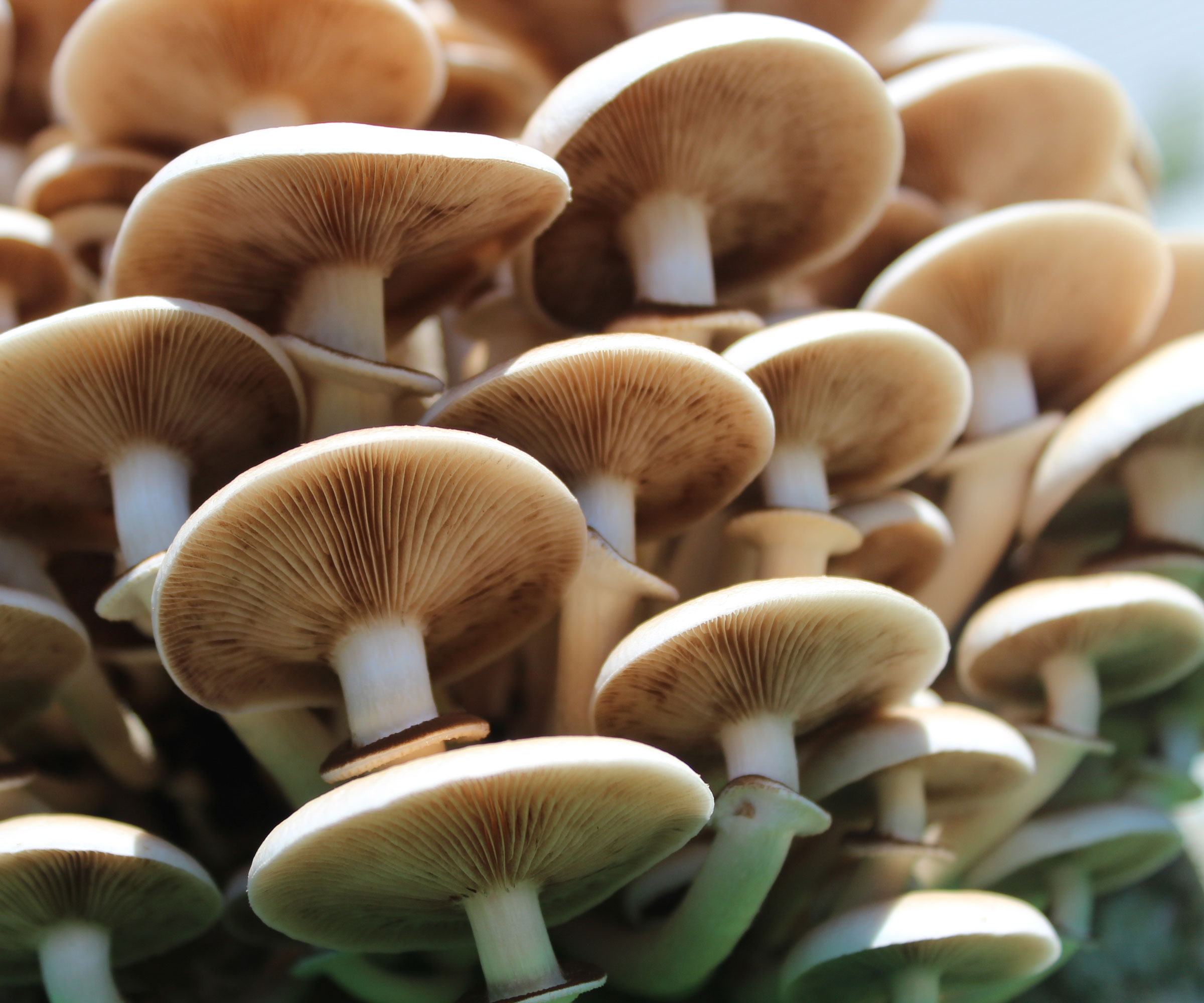
Pioppino mushrooms (Agrocybe aegerita) have slim and slender stems. They also have nutty, peppery caps that pop up on aspen shavings and oak pellets. Usually, this happens in 3-5 weeks at 60-70°F (16-21°C) with 85-90% humidity and very soft light. Kits keep it low-fuss for those that are just starting out. You just need a misting bottle and a shady corner.
Their earthy zing sparks risottos or roasted veggie dishes. They are perfect for the small-space grower chasing bold flavors. Outdoors, hardwood logs like poplar or willow excel in shaded beds.
7. Chestnut
Chestnut mushrooms (Pholiota adiposa) grow golden-brown, meaty caps. They grow well with oak pellets or hardwood sawdust at 60-70°F (16-21°C) with 85-90% humidity and dim light. Meeting these conditions, chestnut mushrooms will fruit in approximately 3-6 weeks.
Chestnuts are quite low maintenance – they just need a damp nook. Their robust, slightly sweet flavor shines in sautés or soups. Outdoors, hardwood logs like oak or alder excel in shaded spots.
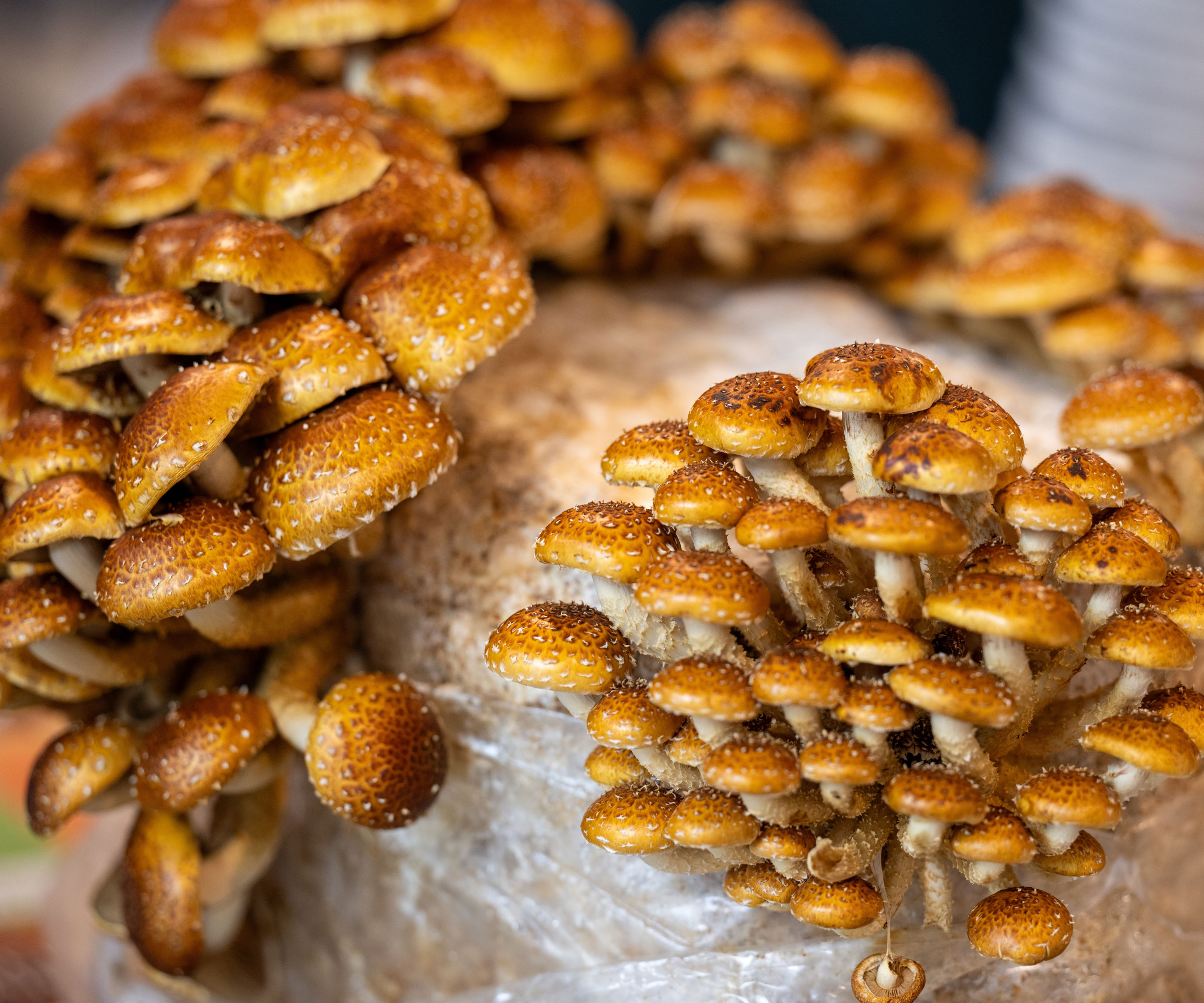
Harvesting Homegrown Mushrooms
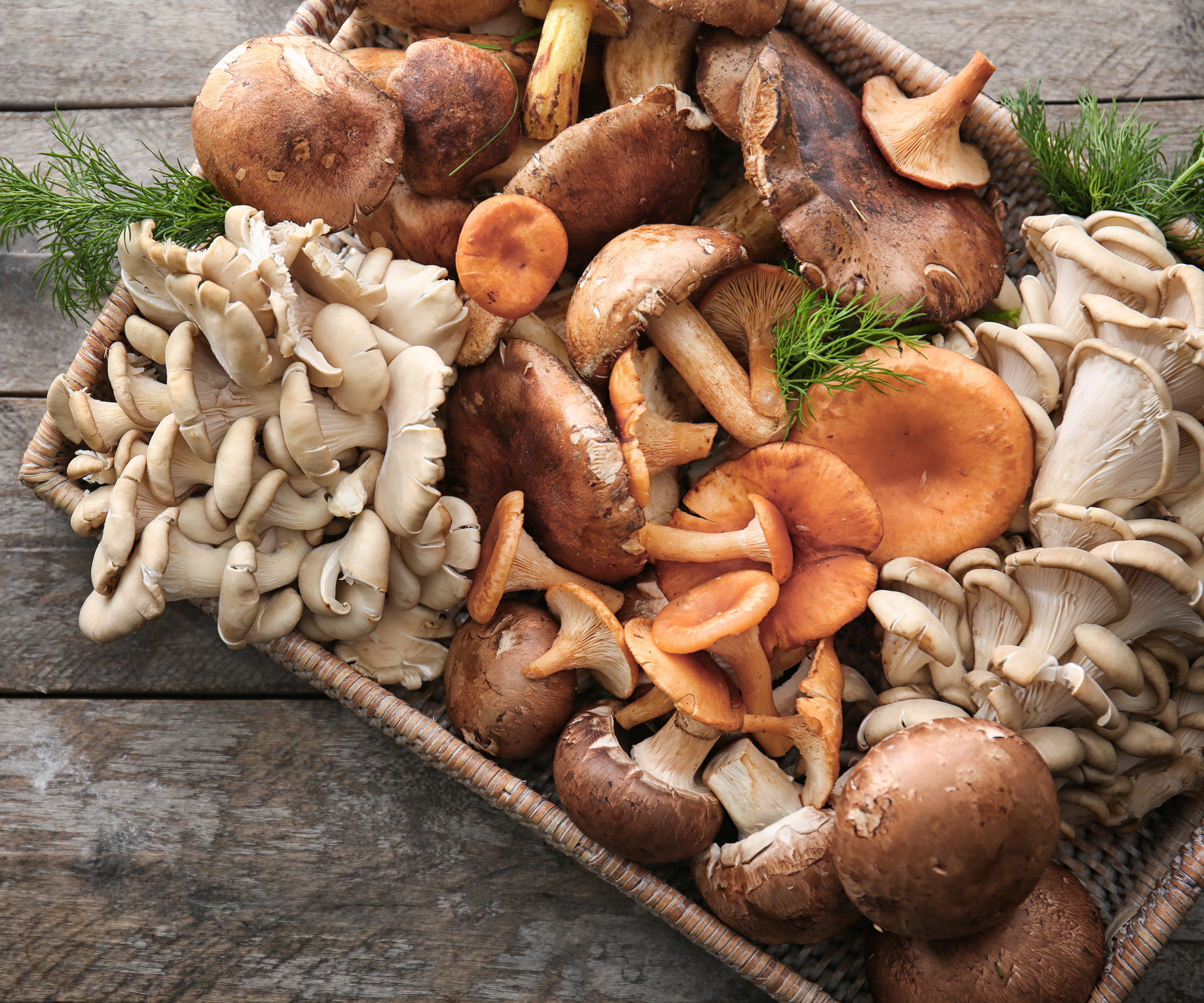
You’ll know it’s harvest time when oyster caps start to level out, or when gills start to show on shiitake mushrooms, wine caps, pioppino, portobellos, and chestnut varieties. With lion’s mane, you can harvest when the ‘teeth’ are about ¼ in (6mm) long. Depending on the variety, that stage usually comes 2-6 weeks after pinning.
Don’t cut your mushroom – just give a gentle twist at the base, so the mycelium stays healthy and you can pull a few more rounds from the same block. Paper bags in the fridge, at 35-40°F (2-4°C), will keep harvests good for a week or two. Alternatively, a dehydrator like the Corsori Food Dehydrator from Amazon, set low at 110°F (43·C), will dry them for long-term storage.
Cooking is where they really shine, though. Oysters turn into buttery taco filling. Lion’s mane cooks dense and meaty, like steak. Shiitake soaks up soy for stir-fries, while portobellos grill beautifully with olive oil and herbs. Pioppino adds a subtle bite to risotto, and chestnuts bring a deep, sweet flavor to soups.
Remember These Tips for Success
Hopefully, this has given you plenty of inspiration to make a confident start on your way to delicious homegrown mushrooms. Just remember:
- Hold humidity steady at 80–95%, misting daily and running a small fan for light airflow to keep conditions balanced.
- Don’t put mycelium in direct sunlight – it burns out fast. Instead, give it shade or a dim corner with 6–12 hours of gentle light.
- Strange odors, slimy spots, or bright colors are warning signs. Green or black mold is a sign of contamination. However, if you see white fuzz or ropey threads, this is good as it means the mycelium is healthy.
- Sterilize tools with 70% alcohol and use a still air box or flowhood for clean work. Overwatering tanks substrates, so mist only when dry.
- Outdoor inoculation can crash with weather swings, so time wine cap beds for early fall and mulch to block pests. Temps spiking past 75°F (24°C) stall fruiting, so monitor closely.
- Add a diluted liquid seaweed fertilizer (or dilute a concentrate such as TPS Nutrients Seaweed Fertilizer Premium Organic Liquid Kelp from Amazon) post-first flush boosts later yields. Lock in your setup, and these mushrooms will spin scraps into gourmet feasts by winter.
Need more ideas for growing inspiration, timely gardening jobs and seasonal expert advice delivered straight to your inbox? Sign up for the free Gardening Know How Newsletter!
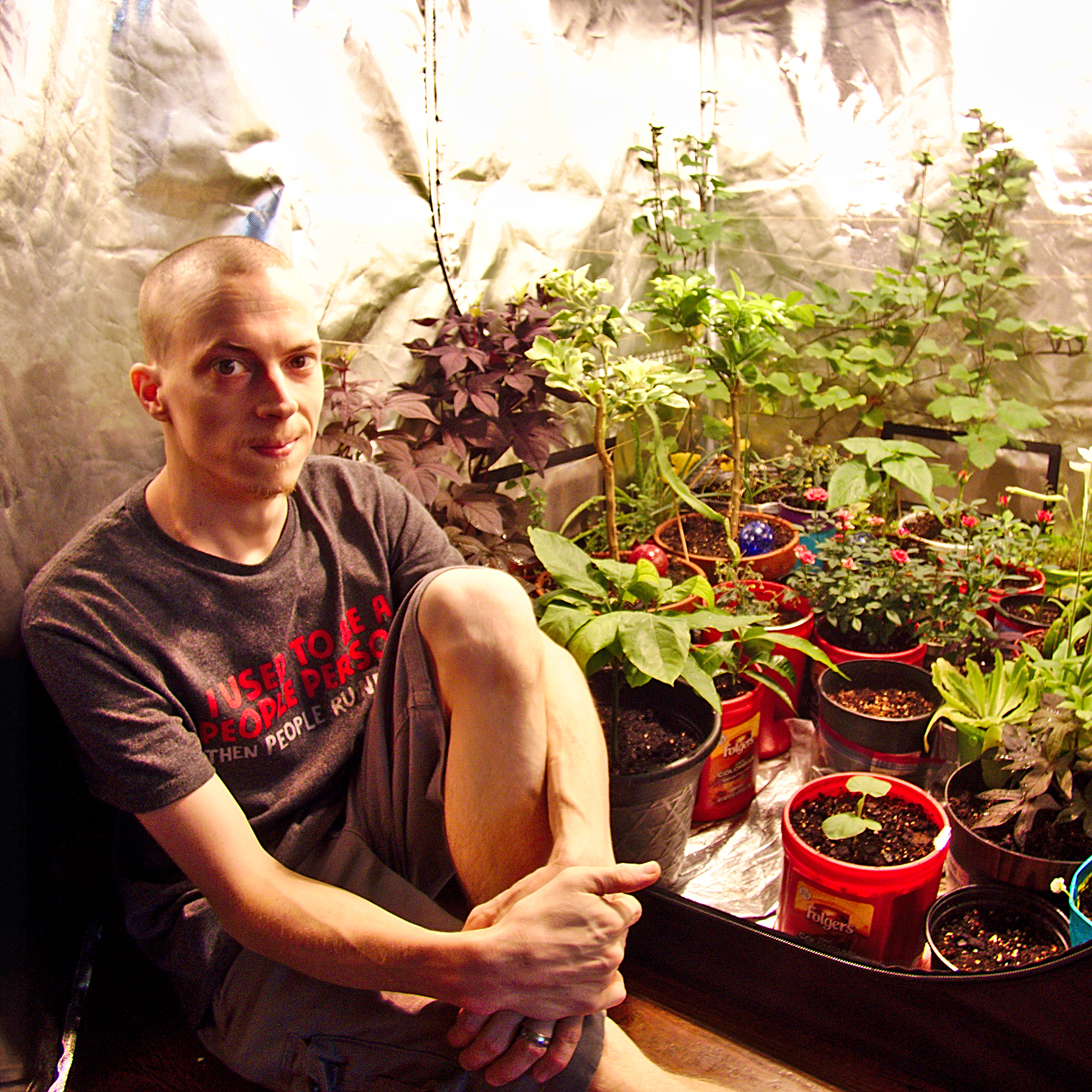
Tyler’s passion began with indoor gardening and deepened as he studied plant-fungi interactions in controlled settings. With a microbiology background focused on fungi, he’s spent over a decade solving tough and intricate gardening problems. After spinal injuries and brain surgery, Tyler’s approach to gardening changed. It became less about the hobby and more about recovery and adapting to physical limits. His growing success shows that disability doesn’t have to stop you from your goals.
- Amy DraissDigital Community Manager
